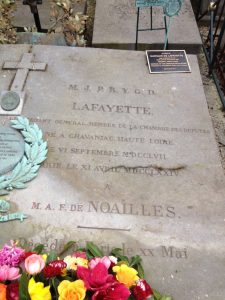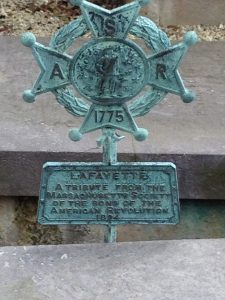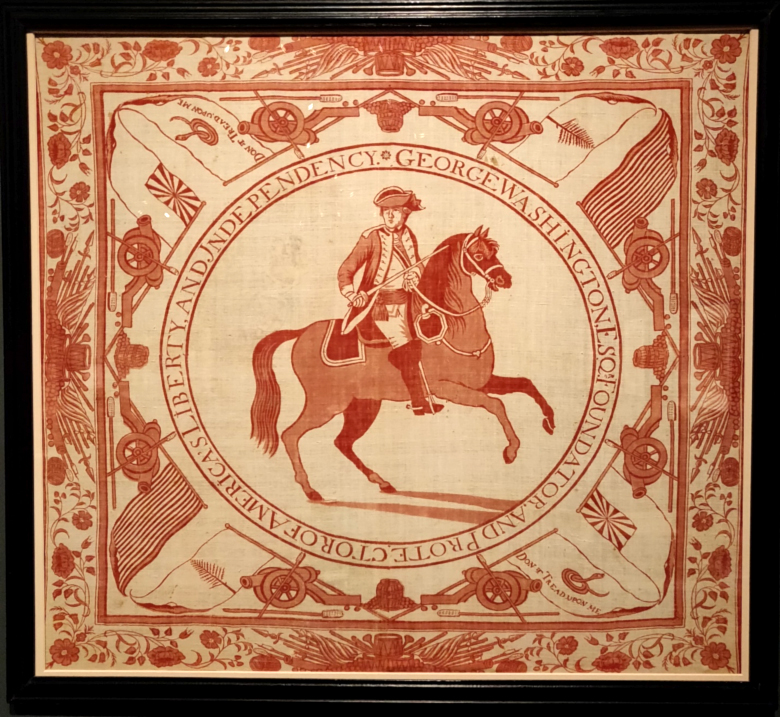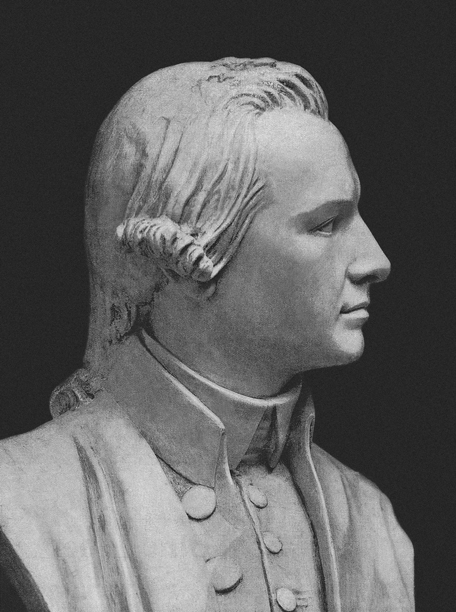I had the opportunity to visit the grave of the Revolutionary War hero the Marquis de LaFayette recently. As the American colonists were seeking to take more local control over their own affairs from the British, fighting against “taxation without representation,” and fighting for “the separation of church and State,” many people outside of America became inspired by what the Americans were attempting to do. It mainly translated overseas as “Liberty” from the oppression of out of touch (British, French, Russian, Polish …) kings, royalty and clergy. The ideals of the American founding fathers were so alluring and intoxicating to men like LaFayette that they gave up their stations in life, in his case, as a very wealthy aristocrat and military officer in France, to join with the Americans in establishing their new nation based on these principles.
LaFayette left France at a young age to learn from George Washington, to serve under him, and to join the fight for American independence. He became one of the main actors in the American Revolutionary war. He contributed his own personal wealth and solicited and raised funds from the French government for the American Revolution. He led soldiers in battle against the British and he eventually held senior positions in the Continental Army.
Seen in America and in France as an active proponent of a peoples’ pursuit of self-determination, LaFayette was admired for his selfless acts of valor in support of American ideals. After “1776” France went through her own revolution. LaFayette became a key figure in the French Revolution (1789) and Napoleon’s evangelizing wars throughout Europe as well.
Lafayette was married to Adrienne de Noailles. Her family was mostly guillotined during the 1794 Reign of Terror (as per the 1934 movie The Scarlet Pimpernel starring Leslie Howard and Merle Oberon). At that time French citizens were purging society of what they considered parasitic aristocrats and clergy, enemies of the revolution, who had been ripping them off and oppressing them for many generations. The death toll of those executed by guillotine exceeded 16,000.
The bodies of Adrienne’s family members were taken to secret burial holes, mass graves with hundreds of other guillotined corpses. Being Lafayette’s wife, wife of the hero of American ideals, values which the French citizens shared, she was spared the guillotine; allowed to keep her head.

At some point later on, Adrienne and others of the surviving aristocrats secretly found the location of these mass graves, barely a quarter mile from the guillotines (at the time known as Square of the Overturned Throne, now Place de la Nation). These families joined together and quietly bought the land to begin converting it to a cemetery to honor their ancestors and pray for their souls. Today it is the only private cemetery in Paris, the Picpus Cemetery. The entrance is at 35 rue de Picpus, Paris XIIeme.
When Adrienne died in 1807, she was buried at Picpus among her beheaded and unidentifiable family members. It is a fascinating memorial to the victims of “the Terror” – humble, under-decorated, understated, even for a cemetery. The mass-grave grounds are undisturbed and the old aristocratic tombs from after “the Terror” are in decay. LaFayette died in 1834 after a very conflicted life trying to keep the ideals of both revolutions alive and applied in successive French governments. He is buried next to Adrienne at Picpus.
One of LaFayette’s dying wishes was to be buried in American soil. On his last visit to America (there were twenty-four American States at the time) he brought back to France a large trunk full of American soil from Bunker Hill outside of Boston. His son, Georges Washington Lafayette, complied with his wish, spreading the American dirt over his interred remains, filling his grave. Historian and Professor Emeritus of History at the University of Wisconsin John P. Kaminski tells us in his book Lafayette, the Boy General (Madison, WI: Parallel Press),
He was buried in Picpus cemetery next to his wife, in soil brought back from Bunker Hill in 1825… Originally, Lafayette had planned his burial in soil brought back from each of the twenty-four states he had visited in I824-1825. Unfortunately, toward the end of his American tour, the steamship Mechanic carrying Lafayette, his entourage, and the soil that Lafayette had collected, sunk in the Ohio River. The next best thing, Lafayette thought, was soil from Bunker Hill.
Since about the 1850s, an American flag has stood over the grave. There are also various other humble honorifics marking his grave by historical societies from Massachusetts to Virginia and beyond. And periodically there sits a large bouquet of fresh flowers on the site, as on the day of my visit.

We have a curious historic detail attesting that the cemetery is indeed inconspicuous. During the Nazi occupation of Paris in World War II there was a Rothschild-funded Jewish hospital located just across the street from number 35 Rue de Picpus. One can imagine the terror that hospital suffered during the occupation. Yet the church grounds, notably the American flag within, remained undisturbed during the Nazi occupation of Paris from 1940 to 1944. Again, according to Kaminski, “Set back from the street and enclosed by a high stone wall, the grave is inconspicuous. [The] American flag was never noticed by the German occupiers.”
To me it was interesting to approach Picpus traveling by Paris metro and exiting at the Place de la Nation. That is where all of the terror, all of the guillotining took place. After exiting the metro gates, before exiting the station, there are large wall maps of the area, indicating which is Rue de Picpus. Follow the Rue de Picpus to the left to number 35, located on the left hand side of the street. At number 35 is the portal entrance into the walled off, maybe five acres, of church grounds. Upon paying a small fee you may either wander the grounds or walk the broad gravel path to the left of the church facing you. As private church grounds, the markings are not frequent or clear. So simply make your way to the far left corner until the cemetery reveals itself. Many of the graves are ornate, above ground, sarcophagus-like tombs. Lafayette and his wife are in-ground with granite markers. It will be obvious once you are in the cemetery. And the mass-grave site is found just to the left of Lafayette’s grave.









2 Comments
I have done a little graveside visiting as well. George Washington and Thomas Jefferson: buried in their own backyards. Benjamin Franklin: center of Philadelphia. John Adams: in a church next to his son John Quincy Adams, in a church in Quincy, Massachusetts. Nathanael Greene, buried in Savannah, Georgia, a thousand miles from his Rhode Island home. George Rogers Clark and Daniel Boone: in Louisville and Frankfort, Kentucky, respectively. Yet the most interesting burial place (to me) is the state park in Remsen, New York, dedicated to General Friedrich Steuben. It is located at the site of his remote post Revolutionary war log cabin – which is still rather remote, eighteen miles off the interstate highway. Steuben’s grave with an impressive monument is in the woods behind the cabin, surrounded by trees, and if there was no state park or signs it would get no visitors at all.
Where did the author come up with “fighting for ‘the separation of church and State?'” This is a fantasy of recent vintage. Many of the American colonies had a ‘state religion’ which usually coincided with the predominant religious sect of the colony.
During the War of Independence, some of the new states actually wrote a state religion into their State Constitution. When the Bill of Rights was considered by the First Congress, Madison avoided a squabble over the appropriate religion of the United States. The individual states could have a “state religion” but the United States would not. In the 1840’s, Massachusetts became the last state to eliminate the “state religion.”
The motivation for Massachusetts is sometimes explained as a desire to conform to the general character of the other States. My conjecture is that the influx of Irish Catholics immigrants raised fear in the Boston Brahmins that Roman Catholicism would gain ascendency and Catholicism would become the state religion.
As for the concept of ‘separation’; this does not appear in the Constitution which says “Congress shall make no law respecting an establishment of religion.” This is a ‘one way street’ limiting Congress but organized religion was free to influence Congress.
The meaning of the Religious clause of the Constitution was self-evident for most of American history with some minor commentary. In 1802, Jefferson wrote a letter regarding a “wall of separation.” However, Jefferson was not at the Constitutional Convention nor at the First Congress. Although his friends exchanged correspondence with him they did not want him in Philadelphia.
There were many good reasons to keep him away. During the Revolutionary War he took credit for writing the Declaration of Independence when it was the work of several individuals. As for the First Amendment’s religion clauses, Jefferson wrote his opinion to his friends who did not voice Jefferson’s concerns to other Congressmen.
It was not until 1947, in Everson v. Board of Education, that one of the most divisive Supreme Court justices, Hugo Black, repeated Jefferson’s “wall” metaphor to support a limitation on State support of parochial schools.
In Everson, the pesky Catholics in southern New Jersey wanted the State to pay bus transportation children going to parochial school. In New Jersey’s large cities, it was a long time practice for all students to ride public transportation for free. This procedure had passed judicial muster in the past.
This should have been a two page decision as there was precedent for the State to provide for children’s education, safety and transportation.
Black’s lengthy decision ruled that New Jersey and its municipalities would provide free transportation in rural area. However, Black went far afield positing a barrier when the US Constitution only erected a low curb-stone boundary. Some commentators point to Black being a former KKK member who was known for anti-Catholic rhetoric in the 1920’s when he ran for public office. Possibly, Black had anti-Catholic animus 20 years later. But, he was joined by four other judges, who agreed to his exposition on parochial education — the decision was 5-4.
As a matter of completeness, I acknowledge that in the 1879 Reynold’s case, the Court quoted Jefferson’s 1802 letter. In this case, Reynold’s was prosecuted for polygamy and he asserted a defense that more than one wife was mandated by his religious conviction. Justice Waite wrote a fulsome discussion of English and American law regarding polygamy and religion. He did mention Jefferson’s “wall of separation.”
A moment’s thought would indicate that if there was a substantial “wall” then then the government should not have prosecuted Reynolds. The Supreme Court, citing centuries of Anglo-Saxon jurisprudence, affirmed Reynolds guilt. The decision was unanimous as to the holding and most of the analysis — one judge took issue with one minor point.